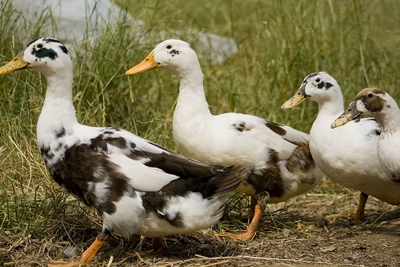A quick word on blocking ads

It looks like you are using an ad blocker. That's okay. Who doesn't? But without advertising revenue, we can't keep making this site awesome. Click the link below for instructions on disabling adblock.
Welcome to the Newschoolers forums! You may read the forums as a guest, however you must be a registered member to post. Register to become a member today!
The Ancona was developed in Great Britain during the early twentieth century and most likely originated from Runner ducks and Huttegen ducks, an old Belgian duck. This is the same foundation stock as the Magpie duck. "They have been raised in the United States for several decades and were exhibited in 1983 in Oregon. Although still rare, their numbers have been increasing since 1984 when they first became available to the public." (Holderread 2001, 53)
The Ancona averages 6 to 6.5 pounds and is a bit stockier than its close relative, the Magpie duck. It has a medium sized oval head, a medium-length bill that is slightly concave along the top line, an average neck that arches forward slightly and body carriage is 20 to 30 degrees above horizontal. The broken, mottled plumage is unique among ducks for, like Holstein cattle, there is no set design. "Any combination of white and color is acceptable as long as there are obvious broken areas on the head, backs, sides, and underbody." The neck is normally solid white, bills are yellow with dark green or black spotting, and the legs and feet are orange with black or brown markings that increase with age. (Holderread 2001, 53) Varieties include Black and White, Blue and White, Chocolate and White, Silver and White, Lavender and White, and Tricolored. Chocolate is a sex-linked recessive trait. If a chocolate drake mates with a black duck, all female offspring will be chocolate, while all male offspring will be black. A black drake mated to a chocolate duck produces all black offspring. Only male offspring will carry the sex-linked recessive chocolate gene. (Holderread 1985, 4)
The Ancona is a hardy, adaptable, all-purpose duck. It is an excellent layer, typically laying 210-280 white, cream, or blue eggs yearly. The Ancona also grows relatively quickly, and produces high quality meat that is more flavorful and less fatty than that of most Pekin ducks. Anconas are well suited for situations where they can forage for some of their food and are capable of eating large "banana" slugs. "They make excellent pond or yard ducks since they tend to stay close to home, do not fly under normal conditions and are large enough so that they are less likely to be preyed upon by winged predators. Typically they have moderately calm temperaments and make fine pets." (Holderread 2001, 52)
"As with all rare breeds, it is especially important to choose stock birds that are vigorous, free of physical deformities and have classic breeds traits. Since it is an excellent layer, productivity should be given a high priority in breeders. To produce the highest percentage of offspring with unique patterns, select birds with definite colored areas under their eyes and at least a bit of color in their chests. Avoid specimens that are either solid white or primarily colored with a white bib." (Holderread 2001, 53) While the Ancona is not yet recognized by the American Poultry Association, one breeder suggests the ideal aesthetic is three quarters white plumage and one quarter colored.
ALBC's 2000 census of domestic waterfowl in North America found only 128 breeding Ancona. While four people reported breeding Ancona, only one primary breeding flock with 50 or more breeding birds exists. (Bender, 4) There is a critical need for more conservation breeders of Ancona ducks. Their excellent laying ability, tasty meat, and calm dispositions make them a great addition to any small farmstead or backyard producer's flock.
